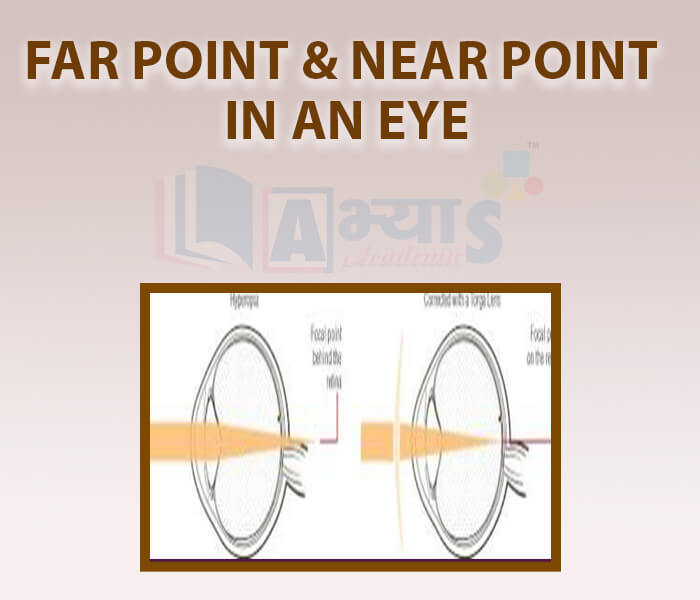Far point and near point in an Eye







Far Point and Near Point in an Eye
Far Point And Near Point: Although the power of accommodation of the eye is amazing, it has certain limitations. The focal length of the eye cannot adjust enough to form sharp images of objects kept beyond a certain point and closer than a certain point.
|
The farthest point up to which the eye can see properly is called the far point of the eye. For the normal eye, the far point is at infinity. When viewing an object at the far point, the ciliary muscles are in their most relaxed state, and the crystalline lens is at its thinnest (Figure 2.27a). Thus, the eye-lens is at its maximum focal length when looking at an object at the far point. As an object is brought closer to the eye, the ciliary muscles contract. This increases the thickness of the crystalline lens and decreases the focal length of the eye-lens. This helps to form a sharp image on the retina. At a certain point near the eye, the ciliary muscles reach the limit of their contraction. If an object is brought closer still, the ciliary muscles cannot contract further. The closest point at which an object can be placed and seen clearly is called the near point of the eye. And, the distance of the closest point at which an object can be placed and seen clearly is called the least distance of distinct vision or the least distance of clear vision |
 |
When an object is placed at the near point (that is, at a distance equal to the least distance of distinct vision), the curvature and thickness of the crystalline lens are maximum and the focal length of the eye-lens is minimum.
.The near point of the eye varies from person to person and with age. At a very young age (below 10 years), the ciliary muscles are strong and flexible, and therefore, they can contract to a great extent. At this age, the near point may be as close as 7 to 8 cm from the eye. In old age, the ciliary muscles lose flexibility, and hence, the ability to contract to the required extent is lost.As a result, the near point reaches to 1 to 2 m, or even more. However, the standard value of the least distance of distinct vision for the normal human eye is taken as 25 centimetres.
Which of the following are correct : (a) The eye-lens is at its maximum focal length when looking at an object at the far point. (b) The eye-lens is at its minimum focal length when looking at an object at the far point.
| |||
| Right Option : A | |||
| View Explanation | |||
When an object is placed at the far point, the curvature and thickness of the crystalline lens are ___________and the focal length of the eye-lens is ______________. | |||
| Right Option : A | |||
| View Explanation | |||
The farthest point up to which the eye can see properly is called the __________________. | |||
| Right Option : B | |||
| View Explanation | |||
Students / Parents Reviews [10]
It was good as the experience because as we had come here we had been improved in a such envirnment created here.Extra is taught which is beneficial for future.

Eshan Arora
8thOne of the best institutes to develope a child interest in studies.Provides SST and English knowledge also unlike other institutes. Teachers are co operative and friendly online tests andPPT develope practical knowledge also.

Aman Kumar Shrivastava
10thAbout Abhyas metholodology the teachers are very nice and hardworking toward students.The Centre Head Mrs Anu Sethi is also a brilliant teacher.Abhyas has taught me how to overcome problems and has always taken my doubts and suppoeted me.

Shreya Shrivastava
8thA marvelous experience with Abhyas. I am glad to share that my ward has achieved more than enough at the Ambala ABHYAS centre. Years have passed on and more and more he has gained. May the centre flourish and develop day by day by the grace of God.

Archit Segal
7thAbhyas is a complete education Institute. Here extreme care is taken by teacher with the help of regular exam. Extra classes also conducted by the institute, if the student is weak.

Om Umang
10thMy experience was very good with Abhyas academy. I am studying here from 6th class and I am satisfied by its results in my life. I improved a lot here ahead of school syllabus.

Ayan Ghosh
8thMy experience with Abhyas academy is very good. I did not think that my every subject coming here will be so strong. The main thing is that the online tests had made me learn here more things.

Hiya Gupta
8thAbhyas Methodology is very good. It is based on according to student and each child manages accordingly to its properly. Methodology has improved the abilities of students to shine them in future.

Manish Kumar
10thI have spent a wonderful time in Abhyas academy. It has made my reasoning more apt, English more stronger and Maths an interesting subject for me. It has given me a habbit of self studying

Yatharthi Sharma
10thIt was a good experience with Abhyas Academy. I even faced problems in starting but slowly and steadily overcomed. Especially reasoning classes helped me a lot.
